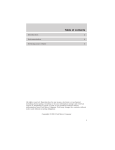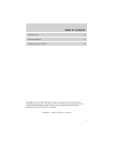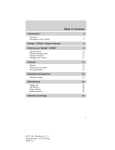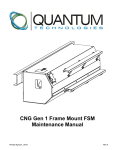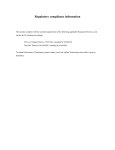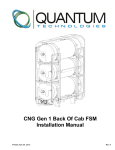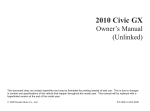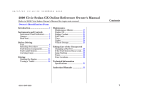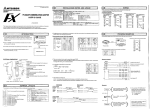Download Ford 2003 Explorer Automobile User Manual
Transcript
Table of contents Introduction 2 Instrumentation 4 Servicing your vehicle 5 All rights reserved. Reproduction by any means, electronic or mechanical including photocopying, recording or by any information storage and retrieval system or translation in whole or part is not permitted without written authorization from Ford Motor Company. Ford may change the contents without notice and without incurring obligation. Copyright © 2003 Ford Motor Company 1 Introduction Introduction ABOUT THIS SUPPLEMENT This booklet supplements your Owner Guide and is part of the owner’s portfolio. It describes the operation of your natural gas vehicle (NGV) and how it differs from a standard gasoline powered vehicle. Therefore it is very important that you read this guide and thoroughly familiarize yourself and others operating the vehicle with this information. Some of the information in this supplement replaces certain instructions in the Owner Guide. Please read this supplement carefully and completely. Refer to the Owner Guide for complete vehicle information. WARNINGS Warnings remind you to be especially careful in those areas of the vehicle where carelessness can cause damage to your vehicle or possible personal injury to yourself, your passengers or others. Please read all warnings carefully. ABOUT THE WARRANTIES The normal vehicle warranties will apply to your NGV. For further information, refer to your Warranty Information Booklet. Specified maintenance procedures must be followed. Repairs must be made by trained personnel. It is important that your NGV be properly maintained by qualified Ford trained gaseous fuel service technicians. If a problem occurs, it is important that properly trained personnel diagnose and repair the cause. If the problem relates to the fuel system, proper part replacement is imperative to keep your vehicle operating correctly. NGV fuel system components and standard gasoline fuel system components are not interchangeable. If your NGV is not maintained in accordance with approved service procedures, damage may occur and your warranty may be invalidated. Any modification to the fuel system of your NGV voids the Ford New Vehicle Limited Warranty. 2 Introduction COMPRESSED NATURAL GAS (CNG) FUEL SYSTEM Your vehicle is equipped with a dedicated compressed natural gas (CNG) fuel system that is under high pressure. Depending upon the application, the CNG fuel system is rated at a pressure of 20,700 kPa (3,000 psi) at 21°C (70°F) or 24,800 kPa (3,600 psi) at 21°C (70°F). Refer to the label on the fuel filler door to determine the fuel system pressure rating. Use caution when servicing or maintaining any of the components of the CNG fuel system. Service to high-pressure fuel system components must be conducted only at qualified dealerships by qualified technicians. Failure to do so may cause damage to components or cause bodily harm. On F-150 Heritage natural gas vehicles, do not modify or replace the bed with any non-OEM components. Should the bed need to be removed for service or replacement, it should be done by a qualified dealership using qualified technicians. Do not sit, stand or place heavy loads on the in-bed or in-vehicle tank covers. Any bed cap added to this vehicle must be well ventilated. Failure to provide adequate ventilation could result in gas vapor build up over time potentially resulting in a combustible mixture. FUSES/ELECTRICAL SYSTEMS NGV fuse strategy may be different than a non-NGV. Consult the Fuses and Relays section in the Roadside emergencies chapter of your Owner’s Guide for differences. 3 Instrumentation Instrumentation FUEL GAUGE The fuel gauge in your NGV behaves similarly to a typical gasoline fuel gauge. However, the gauge operation is based on the pressure and temperature of the natural gas, not on the level of liquid gasoline. Depending upon application, a fuel gauge reading of Full will occur at a pressure of approximately 20,700 kPa (3,000 psi) or 24,800 kPa (3,600 psi), at a temperature of approximately 21°C (70°F). The NGV fuel gauge will provide a linear reading from this point down to Empty. Refer to the Fueling section of this supplement for more information on fuel gauge performance during the fast-fill method of fueling. 4 Servicing your vehicle Servicing your vehicle CNG FUEL SYSTEM COMPONENT IDENTIFICATION The following illustrations depict the major unique components of the CNG fuel system. All of these unique components are constructed of special materials that withstand the effects of CNG. NEVER replace a unique CNG fuel system component with a standard gasoline fuel system component or any aftermarket component. E-Series Van 5 Servicing your vehicle E-450 Cutaway 1. Fuel rail sensors - An injection pressure sensor and an engine fuel temperature sensor provide engine fuel information to the powertrain control module. 2. Isolation solenoid valve - Blocks fuel flow from supply line to injection manifold when the engine is off. 3. Engine - A modified 5.4L gasoline engine with Sequential Electronic Fuel Injection (SEFI), an improved valvetrain and a high compression ratio. 4. Powertrain control module - Uniquely calibrated for NGV application. 5. Extended range fuel tank - An optional steel fuel tank located in the cargo area. 6. Sealed vent box - Dispenses natural gas vapor to atmosphere if vapor becomes present. 7. Internal tank valve - One electronically actuated, normally closed solenoid valve is located in each fuel tank. The valve is wired into the vehicle’s inertia switch. If the engine cranks but does not start after a collision, the fuel solenoid valve inertia switch may have been activated. The inertia switch is a device intended to close the fuel solenoid valve when your vehicle has been involved in a substantial jolt. 8. Stone shield(s) - Protective shield(s) to prevent damage to the fuel tank(s) caused by road debris or other road hazards. 6 Servicing your vehicle 9. Aft axle fuel tanks - Two steel fuel tanks located behind the rear axle. 10. Midship fuel tank - A steel fuel tank located underbody. 11. High pressure fuel lines - Delivers high pressure fuel to the fuel tanks and fuel pressure regulator. 12. Fuel pressure regulator/Coalescent fuel filter - Reduces fuel pressure and removes impurities from the gas. 13. Low pressure fuel line - Supplies natural gas to the injectors. 14. AFV module - Contains the unique powertrain electronics that are required for an NGV. F-150 Heritage Pick-up 1. Fuel rail sensors - An injection pressure sensor and an engine fuel temperature sensor provide engine fuel information to the powertrain control module. 2. Isolation solenoid valve - Blocks flow from supply line to injection manifold when the engine is off. 3. Engine - A modified 5.4L gasoline engine with Sequential Electronic Fuel Injection (SEFI), an improved valvetrain and a high compression ratio. 4. Powertrain control module - Uniquely calibrated for NGV application. 5. Internal tank valve - One electronically actuated, normally closed solenoid valve is located in each fuel tank. The valve is wired into the 7 Servicing your vehicle vehicle’s inertia switch. If the engine cranks but does not start after a collision, the fuel solenoid valve inertia switch may have been activated. The inertia switch is a device intended to close the fuel solenoid valve when your vehicle has been involved in a substantial jolt. 6. Standard fuel tanks - Two steel fuel tanks located in the bed of the truck. 6b. In-bed tank cover - Cover to prevent damage to the fuel tanks. Protective shield to prevent damage to the fuel tank caused by road debris or other road hazards. Do not sit, stand or place heavy loads on the fuel tank cover. 7. Stone shield - Protective shield to prevent damage to the fuel tank caused by road debris or other road hazards. 8. Underbody fuel tank - A steel fuel tank located underbody. 9. High pressure fuel lines - Delivers high pressure fuel to the fuel tanks and fuel pressure regulator. 10. Fuel pressure regulator/Coalescent fuel filter - Reduces fuel pressure and removes impurities from the gas. 11. Low pressure fuel line - Supplies natural gas to the injectors. 12. AFV module - Contains the unique powertrain electronics that are required for an NGV. Crown Victoria 2 1 4 5 6 7 8 9 3 10 11 12 14 19 18 17 16 13 15 1. NGV module - Provides power for the fuel injectors. Also, drives the fuel gauge using fuel tank pressure and temperature sensors. 8 Servicing your vehicle 2. Isolation solenoid valve - Blocks flow from the injection manifold when the engine is off. 3. Engine - Is a modified 4.6L engine with Sequential Electronic Fuel Injection (SEFI) and increased compression ratio. 4. Engine coolant lines - Provide required heat to high pressure regulator. 5. Powertrain control module - Required for NGV application. 6. Sealed vent box - Vented to underbody. Dispenses natural gas vapor to atmosphere if vapor becomes present. 7. Tank pressure sensor - Fuel tank pressure sensor located in this tank’s solenoid valve is used for fuel indication. 8. Solenoid tank valves - One solenoid per tank. Internal valves with shut-off solenoids wired into inertia circuit for crash protection. 9. Two fuel tanks - Located in the trunk. On taxi or police vehicles, an extended range fuel system is available which includes one additional NG fuel tank mounted in the trunk (total of three). 10. Fueling point - Fueling receptacle is conveniently located with the fuel door. Same location as gasoline fueled vehicles. 11. Tank shield- Protective shield able to prevent damage to the fuel tanks caused by trunk cargo. 12. Tank temperature sensors - One each in set of tanks (solenoid valves) used for fuel indication. 13. Optional fuel tank - A fiber-wrapped steel fuel tank (total of three tanks in the trunk). Also has a sealed vent box which vents to the underbody. Dispenses natural gas vapor to the atmosphere if vapor is present. 14. Two fuel tanks - Located underbody to facilitate fuel system design. 15. Stone and heat shield - Protective shield able to prevent damage to the fuel tanks caused by road debris or other road hazards. 16. High pressure fuel lines - Delivers high pressure fuel to the pressure regulator. 17. Pressure regulator and coalescent fuel filter assembly Reduces the fuel pressure to the fuel injector. 18. Low pressure fuel lines - Supplies natural gas to the engine. 19. Fuel rail sensors - One injection pressure sensor and one engine fuel temperature sensor provide engine fuel information to the PCM. 9 Servicing your vehicle ADAPTERS DO NOT use fuel receptacle adapters when refueling your vehicle. The profiles of both the natural gas vehicle receptacle and the fuel station nozzles are specified by ANSI/AGA NGV1-1994, CGA NGV1-M94. These profiles are specified for compressed natural gas vehicles and fuel stations for safety purposes. Three separate adapter profiles are available. P24, P30 and P36 respectively, are specified for the three different service pressures of 16,500 kPa (2,400 psi), 20,700 kPa (3,000 psi) and 24,800 kPa (3,600 psi). Your vehicle’s service pressure may be 20,700 kPa (3,000 psi) or 24,800 kPa (3,600 psi), depending upon application. Refer to the label on the fuel filler door: • If your vehicle’s fuel system is rated at 20,700 kPa (3,000 psi), it can be refueled using a P30 or P24 nozzle. However, use of a P24 nozzle will result in an incomplete fill. • If your vehicle’s fuel system is rated at 24,800 kPa (3,600 psi), it can be refueled using a P36, P30 or P24 nozzle. However, use of a P30 or P24 nozzle will result in an incomplete fill. DO NOT over pressurize the CNG fuel system or damage to the fuel system and possible personal injury may occur. NATURAL GAS DISPENSING Do not use liquefied natural gas (LNG) or a CNG that is derived from a process such as flashing (heating LNG). Failure to use the correct type of fuel may cause damage to the engine and fuel system components. Most dispensers have a digital indicator displaying the cost and amount of fuel delivered to your vehicle. Fuel delivery to the vehicle is stopped when the pressure of fuel stored on the vehicle equalizes with the temperature compensated pressure of fuel stored at the station. As the pressure between the station and vehicle equalizes, the cost and quantity meters slow to a near stop. When this occurs, refueling is complete. Certain noises can be expected during the refueling process and may vary depending on the type of fuel station and your proximity to the fuel compression and storage equipment. At the beginning of refueling you might hear the rushing noise of gas entering the vehicle through the station hose and tubing. At the end of refueling, the fuel receptacle on the vehicle may make a high pitch noise or chatter. This is another 10 Servicing your vehicle indication that refueling is nearly complete. Also, the station compression equipment may turn on at any time during the refueling process. FUEL QUALITY Do not use liquefied natural gas (LNG) or a CNG that is derived from a process such as flashing (heating LNG). Failure to use the correct type of fuel may cause damage to the engine and fuel system components. Use only a CNG fuel that meets the specification of NFPA-52 and SAE J1616 in your NGV. Specifications NFPA-52 and SAE J1616 place limits on particulate contamination, oil contamination and moisture content to ensure a quality CNG fuel. The use of a CNG fuel that does not meet specifications NFPA-52 and SAE J1616 is not recommended and may cause engine damage. Use of poor quality CNG fuel may result in: • component failure. • leakage from the fueling point. • poor vehicle operation. Use of poor quality fuel may also result in your warranty being invalidated. Icing while fueling your vehicle An icing condition may occur after fueling your vehicle. This may be due to changes in fuel moisture content, quite often seen during change of seasons. This condition causes your vehicle’s fuel fill valve to remain slightly open, allowing some natural gas to be released. Breathing hydrocarbon gases (CNG) or air which lacks oxygen due to the presence of hydrocarbon gases can result in headache, dizziness and weakness in the arms and legs. In the event of illness due to inhaling hydrocarbon gases, immediately move the victim to fresh air and contact medical emergency personnel. The icing condition may be observed when disconnecting the fuel dispenser’s fill nozzle from your vehicle. You may notice more gas than normal venting from the vehicle fill valve through the vent hose to the dispenser. If this occurs, keep the fill nozzle connected (or reconnect it) and wait about 30 seconds. This will allow the ice to melt. Repeat this procedure as necessary. When normal fuel venting occurs, remove the fill nozzle and stow it as instructed on the dispenser. Do not fuel your vehicle with the ignition in the ON position; doing so may increase the amount of fuel venting during this icing condition. 11 Servicing your vehicle SERVICING YOUR NATURAL GAS VEHICLE Service to the CNG fuel system should be conducted at a qualified dealership by a trained NGV technician only. Failure to do so may cause damage to components or cause bodily harm. FUELING Do not fuel your vehicle with the ignition on the ON position. Failure to do so may cause component damage. Fueling a NGV, with a few exceptions, is very similar to fueling a gasoline vehicle. The same care and cautions used when fueling a gasoline vehicle should be exercised when fueling a NGV. In particular, for safety reasons, an engine must always be turned off when refueling is occurring. Always use the recommended fill nozzle to refuel your vehicle. The fueling point, or fuel receptacle is located near the driver’s side. When refueling, the engine must be shut off. Two methods for filling the fuel tanks are available to NGV owners. The fast-fill method, described below, is available at many of the commercial and privately owned filling stations. The slow-fill method, also described below, is available for purchase or lease from a number of commercial or natural gas utility companies. Fast fill procedure “Fast-filling” a NGV involves rapidly (typical fill time: 3–5 minutes) raising the pressure in the vehicle’s tanks by “fast-fill” refueling station. “Fast-filling” a vehicle provides the greatest convenience to the driver in terms of time spent refueling. However, present “fast-fill” refueling technology does not presently allow a NGV to be completely refueled to its maximum rated capacity. Therefore, “fast-filling” results in a reduced driving range and an initial fuel gauge reading of Full. However, within approximately 10 minutes, the fuel gauge of a NGV that has been “fast-filled” will drop about 1⁄8th of a tank lower to reflect the reduced amount of fuel that was actually added. Slow fill procedure “Slow-filling” a NGV involves slowly raising the pressure in the vehicle’s fuel tank(s) by a slow fill station (typical fill rate: 6-8 hours). “Slow-filling” usually is done overnight and allows the greatest amount of fuel to be added to a NGV. A properly functioning “slow-fill” refueling station will fill the NGV’s fuel tank(s) to a fuel gauge reading of “full” at a temperature of 21°C (70°F). 12 Servicing your vehicle Use caution when fueling your vehicle. Make sure the engine is turned off and all flammable material is extinguished. Observe all Dispensing Equipment Safety Standards and Operating Procedures. The procedure is the same for both fast-fill and slow-fill fueling. 1. Open fuel door and determine the pressure rating of your vehicle’s fuel system. 2. Remove protective cap from the vehicle’s fuel receptacle. Remove any debris that may be present. 3. Follow the natural gas fueling procedures provided by the natural gas dealer and dispense the CNG until the fuel tanks are full or until the flow stops. 4. When refueling is complete, follow the natural gas dispensing equipment’s operating procedures to shut the natural gas flow off. 5. Remove the dispensing connector and put protective cap on the vehicle’s fuel receptacle. Close the fuel door. Refill capacities — BTU equivalent to gasoline E-Series (3000 psi) Fueling method Standard tank With extended range tank Slow-fill 60.9L (16.1 gallons) 92.7L (24.5 gallons) Fast-fill 51.8L (13.7 gallons) 78.7L (20.8 gallons) E-Series (3600 psi) Fueling method Standard tank With extended range tank Slow-fill 70.0L (18.5 gallons) 106.0L (28.0 gallons) Fast-fill 59.4L (15.7 gallons) 90.1L (23.8 gallons) Fueling method Slow-fill Fast-fill E-Series Cutaway 158” Wheelbase (3000 psi) Standard With Extended With Extended tanks Range - One Range - Two In-body Tank In-body Tanks 55.3L 84.0L 112.4L (14.6 gallons) (22.2 gallons) (29.7 gallons) 46.9L 71.2L 95.8L (12.4 gallons) (18.8 gallons) (25.3 gallons) 13 Servicing your vehicle Fueling method Slow-fill Fast-fill Fueling method Slow-fill Fast-fill Fueling method Slow-fill Fast-fill E-Series Cutaway 158” Wheelbase (3600 psi) Standard With Extended With Extended tanks Range - One Range - Two In-body Tank In-body Tanks 63.2L 96.1L 128.7 (16.7 gallons) (25.4 gallons) (34.0 gallons) 53.8L 81.8L 109.4L (14.2 gallons) (21.6 gallons) (28.9 gallons) E-Series Cutaway 176” Wheelbase (3000 psi) Standard With Extended With Extended tanks Range - One Range - Two In-body Tank In-body Tanks 60.9L 89.7L 118.1L (16.1 gallons) (23.7 gallons) (31.2 gallons) 76.1L 100.7L 51.8L (13.7 gallons) (20.1 gallons) (26.6 gallons) E-Series Cutaway 176” Wheelbase (3600 psi) Standard With Extended With Extended tanks Range - One Range - Two In-body Tank In-body Tanks 70.0L 102.6L 135.5 (18.5 gallons) (27.1 gallons) (35.8 gallons) 59.4L 87.1L 115.1L (15.7 gallons) (23.0 gallons) (30.4 gallons) Fueling method Slow-fill Fast-fill F-150 Heritage (3000 psi) Standard tanks 71.9L (19.0 gallons) 60.9L (16.1 gallons) Fueling method Slow-fill Fast-fill F-150 Heritage (3600 psi) Standard tanks 82.1L (21.7 gallons) 70.0L (18.5 gallons) 14 Servicing your vehicle Crown Victoria (3600 psi) Fueling method Standard tanks With extended range system 1 Slow-fill 45.0L (11.9 gallons) 59.1L (15.6 gallons) Fast-fill 38.2L (10.1 gallons) 50.3L (13.3 gallons) 1 Police and Taxi vehicles. Extended range fuel system Crown Victoria Police and Taxi vehicles with the extended range fuel system have a 5–passenger seating configuration with one additional CNG fuel tank mounted in the luggage compartment. E-Series vehicles with the extended range fuel system have one additional CNG fuel tank mounted in the cargo area behind the rear seat. TRAILER TOWING On F-150 Heritage models, your NGV has the capability for towing up to 2,267 kg (5,000 lbs.) using the factory installed step-bumper. It is recommended that the vehicle NOT be modified for towing (i.e.-any frame-mounted hitches). Crown Victoria and E-Series Van/Wagon and Cutaway models are not equipped with a trailer towing option. It is recommended that the vehicle NOT be modified for towing. TOWING YOUR CNG VEHICLE Refer to your Owner’s Guide for towing procedure except E-Series vehicles with the optional tank package which MUST be flat-bed towed. NGV REFUELING STATIONS To obtain a directory of all the refueling stations in the United States, contact the American Gas Association (AGA) at (703) 841–8400 or the national website: www.afdc.doe.gov/refueling.html. In Canada, contact Union Gas at 1–800–265–5277. SERVICING YOUR VEHICLE The following is a brief description of unique maintenance items for your NGV. For a complete list of maintenance items and intervals, refer to your Service Guide. Tank inspection and replacement For your protection, the CNG fuel tanks require visual inspection every three years or 58,000 kilometers (36,000 miles) whichever comes first. 15 Servicing your vehicle The purpose of the inspection is to check for exterior damage to the tank which would shorten its usable life span. This inspection should only be done by qualified NGV Ford service technicians. The expiration date for the tank replacement is stated on each tank label See instructions on fuel container for inspection and service life. Coalescent fuel filter assembly Your vehicle is equipped with a coalescent fuel filter assembly. Its primary function is to remove contaminants; oil and water carryover moisture from the fuel and trap it in the filter bowl. The coalescent filter bowl should be drained every 48,000 kilometers (30,000 miles). Perform fuel system depressurization procedure (outlined in Service Manual) before disassembling the filter to avoid fuel pressure regulator damage. The filter element (FG-985) and housing O-ring seal should also be replaced as specified in the Scheduled Maintenence Guide. Spark plugs Replace spark plugs every 96,000 kilometers (60,000 miles) on E-Series and F-150 Heritage models and every 60,000 km (36,000 miles) on Crown Victoria models. Use recommended nickel-plated platinum spark plugs with the Motorcraft part number AWSF-22FM1 (or equivalent) on E-Series and F-150 Heritage models and spark plugs with the Motorcraft part number AWSF-22FM (or equivalent) on Crown Victoria models. 16
















